HOW LIVE-EDGE FURNITURE IS HELPING PEOPLE RECOVER FROM ALCOHOL AND DRUG ADDICTION
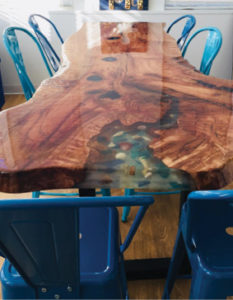 Remember the Shel Silverstein story The Giving Tree? It’s about a tree who loves a boy. Through the years, the tree gives the boy everything she has so that he can make a new life for himself and be happy. After years of striving, empty-handed and old, the boy at last finds rest simply by being with her, even though she is reduced to a stump.
Remember the Shel Silverstein story The Giving Tree? It’s about a tree who loves a boy. Through the years, the tree gives the boy everything she has so that he can make a new life for himself and be happy. After years of striving, empty-handed and old, the boy at last finds rest simply by being with her, even though she is reduced to a stump.
This story reminds me a bit of The Giving Tree. It’s of the trees that endured the stress of years and nature to create beautiful art in their very cores, and the men who created new lives for themselves bringing out the tree’s beauty through live-edge furniture.
THIS ISN’T ABOUT THE LATEST TREND
If you’ve watched HGTV often enough, I’m sure you’ve come across plenty of interiors that use live-edge furniture: island counters, dining tables, coffee tables, bars . . . you name it. It’s definitely a favorite look with the California-cool crowd, the mod and hipster crowd, the mountain cabin crowd, and the tree-hugger, minimalist, Scandi crowd. This style can even be beautifully incorporated into neotraditional interiors.
There are many sources for live-edge furniture, from Etsy and various custom craftsmen across the country to big retail outlets like West Elm and World Market. But I guarantee you, none of them have a story like furniture maker Randy Bartlett.
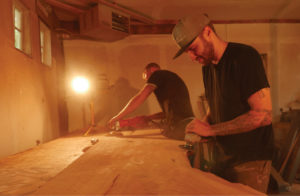 RIVERBANK HOUSE
RIVERBANK HOUSE
It’s impossible to be oblivious to the devasting toll that the opioid epidemic is taking on the lives of our neighbors, friends, and family here in New Hampshire. However, one man is combating this problem in a very interesting and exciting way. And, wonderfully, it has to do with furniture.
Randy Bartlett first started using drugs in the fourth grade. Pot and booze from his parents’ liquor stash, mostly. At age 16, he tried cocaine for the first time, and he was hooked. “I was a horrible addict until I was 21. Miraculously, after a few near-death experiences, I was able to quit on my own,” he says. He continued to use drugs recreationally until he was 32 but made sure to stay away from cocaine. He had a wife and kids, and a flourishing business. “I was successful in spite of myself,” he quips.
Unfortunately, he eventually picked it back up again. So began the vicious, nightmarish cycle of addiction all over again—except that this time he dragged his family into it. Needing a change in the way he saw recovery, Randy went to Burning Tree Ranch, a drug and alcohol rehabilitation center whose focus is not only treating addiction but also preventing relapse into the old patterns of addiction through long-term relapse-prevention planning.
“I’d had enough of crashing and burning,” Randy says. “It was the first time I ever saw recovery through the lens of long-term treatment and the first time I was ever really and truly well.” He returned to New Hampshire as the opioid epidemic raged and decided to do what he could to be part of the solution. In 2012 he founded Riverbank House. An addiction-recovery community for men located in Laconia, Riverbank helps residents build new lives—central to the philosophy of long-term wellness—so they don’t relapse after they leave.
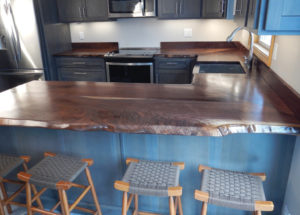 HELPING ADDICTS RESHAPE THEIR LIVES
HELPING ADDICTS RESHAPE THEIR LIVES
While the normal stay for most residential detox programs is 28 days, success rates for such programs hover around 50 percent—often less—for long-term sobriety. Riverbank promotes an extended-care model, leading men through a 12-step program based on meditation and reflection, friendships, responsibility, accountability, and career training. Though they believe a 12-step program is important, they also recognize that the field of addiction science reveals that a one-size-fits-all approach to opioid addiction is not optimal. For this reason, they incorporate multiple avenues to recovery and consider the 12 steps as one of those paths along with Smart Recovery, resources of the Buddhist Recovery Network, and a range of self-responsibility practices.
These concepts are entrenched in their four guiding principles:
- Effective addiction treatment requires long-term care.
- Responsible recovery care addresses the brain impairments that can hinder success.
- Responsible addiction treatment promotes many pathways to recovery.
- Successful recovery requires practice within a safe community.
A key aspect of their treatment program’s belief that there isn’t a single right way to recovery is their belief in spiritual exploration—yoga, meditation, and mindfulness, for example— as well as growth, and internal shift as the foundation of sustainable recovery. To this end, they work with the Venerable Lama Naomh Tomas, their first Spiritual Mentor and Friend-in-Residence, to provide gentle guidance and a compassionate example for their residents.
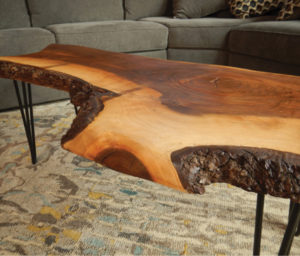 Maintaining a healthy local community is also paramount, so residents have to be clean and sober for five months before they can begin working for Riverbank’s affiliate businesses. “What we’re doing is really unique. We introduce guys to a healthy way of life,” Randy says with smile. “This is a community of guys who are trying to live and grow spiritually. If you do something out of line—not just using drugs but also behavior or responsibility wise—someone is going to call you out. We’re all getting adjusted on a daily basis here.”
Maintaining a healthy local community is also paramount, so residents have to be clean and sober for five months before they can begin working for Riverbank’s affiliate businesses. “What we’re doing is really unique. We introduce guys to a healthy way of life,” Randy says with smile. “This is a community of guys who are trying to live and grow spiritually. If you do something out of line—not just using drugs but also behavior or responsibility wise—someone is going to call you out. We’re all getting adjusted on a daily basis here.”
Riverbank only sees about one in ten of its clients relapse within a year of leaving. “If you get sober for a year, you’re going to change. We don’t have a lot of repeat customers.” Another key piece to the sobriety puzzle is learning a skill that can lead to a career. Enter Vantz Furniture.
FROM LIVING ON THE EDGE TO CRAFTING LIVE-EDGE FURNITURE
Vantz Furniture specializes in live-edge designs and is just one of six businesses that Riverbank runs and staffs with residents and former residents. Randy, always on the lookout for new ventures for his guys, saw an opportunity when one of Riverbank’s businesses, the Karma Cafe in Laconia, needed tables and a bar. Providentially, two of Riverbank’s residents—Kyle Martin and Andi Bauer—have backgrounds in woodworking trades. Andi’s and Kyle’s stories are no less compelling than Randy’s.
Once upon a time, Andi was a carpenter framing houses, but due to his addiction he was homeless for a year and a half. He found Riverbank via the Internet using a restaurant’s WiFi. Despite calling well after midnight, Randy answered the phone after a couple rings and got Andi into care right away.
Kyle was referred to Riverbank House after overdosing. Before that, he built custom lobster boats in Maine, which made him a natural fit for Randy’s plans.
Randy brought in volunteers from the League of New Hampshire Craftsmen to train Kyle and Andi to create those first tables. With that, Vantz Furniture was born. Now both men work at the shop full time—in addition to hours spent mentoring current residents—and are supported by one to two part-time residents, a part-time sales associate, and an administrative assistant.
Vantz boasts a varied inventory of native and exotic live-edge slabs, which have sold well. The venture has already outgrown its first site and has moved to a much bigger warehouse. Currently, most designs are custom-built to order, but their plans for the future include creating an eBay or Etsy shop with some ready-made options. All profits from Vantz and Riverbank’s other businesses fund grants for residents and Riverbank’s program offerings.
FOR MORE INFORMATION:
Riverbank House
riverbankhouse.net
Vantz Furniture
www.vantzfurniture.com

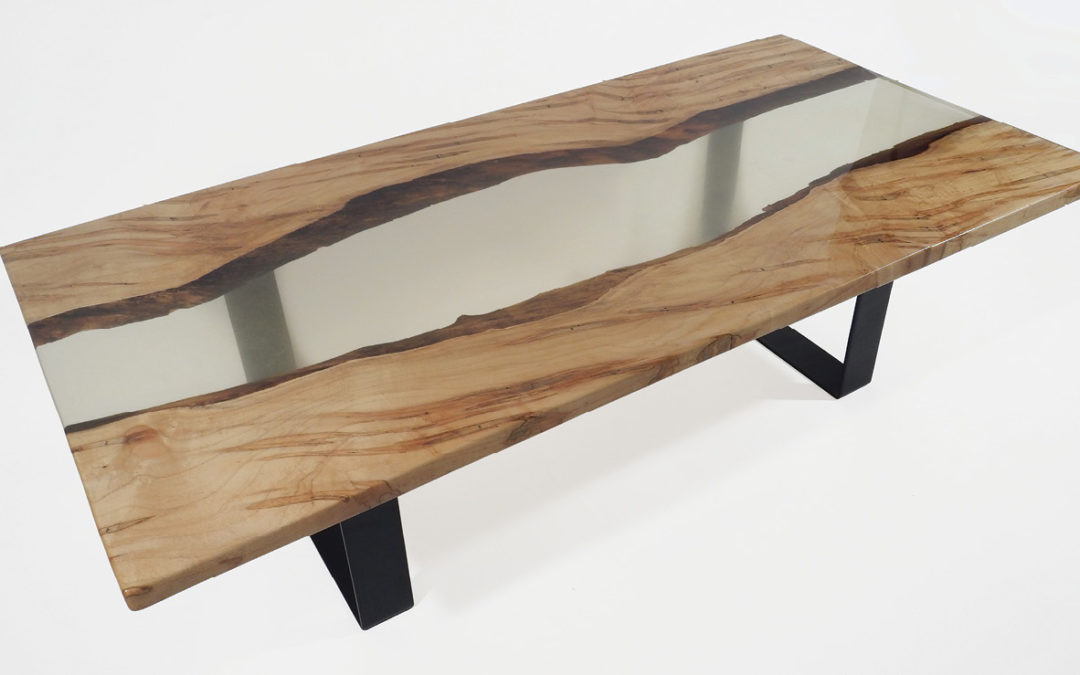
 View Print Edition
View Print Edition